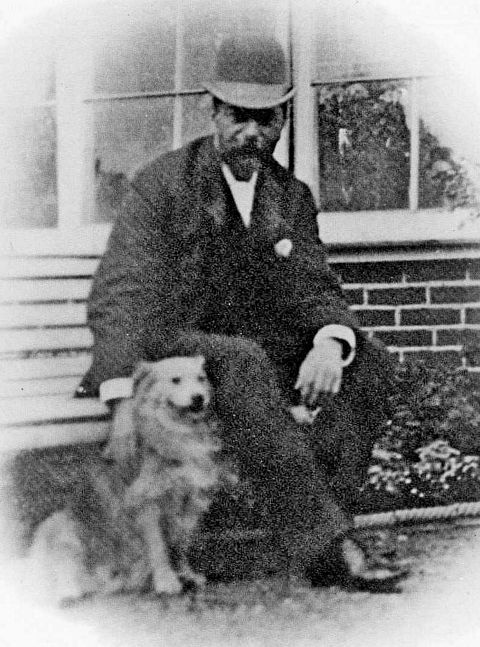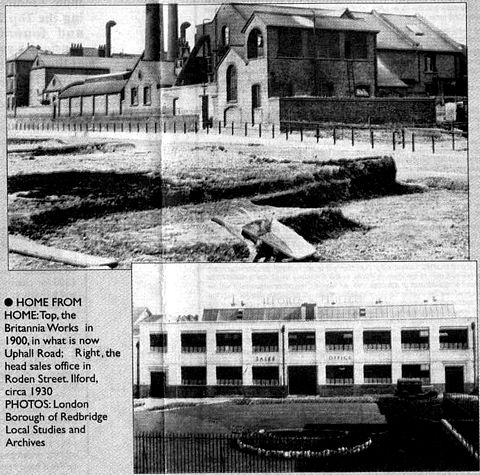|
The following newspaper article
has been sent to me by John Alexander. It was written by Sandra
Lawrence of the London Borough of Redbridge, Local Studies and
Archives, and her copyright is acknowledged.
FOR keen photographers the world over,
Ilford is a famous name. They may know nothing about the town,
but they know about the company which was based here from Victorian
times until 1976 and was synonymous with quality photographic
film and supplies. Sandra Lawrence looks back at the history
of Ilford Ltd and its founder.
|

Founder: Alfred Hugh Harman, 1841-1913.
Spotted the potential of photography in the early days and created
an empire under the name Ilford. |
WHAT better tribute to a
town than to name your company after it?
Thanks to Alfred Harman, Ilford
is known throughout the world - although many people may not
realise that it is actually a place, thinking it is just the
name of the film they put in their camera.
When Harman first started his photographic supplies business
in 1879, he wasn't based in Ilford - but he soon saw
the attractions of a burgeoning town just outside London which
could accommodate not only the rapid expansion of his premises
but could supply the labour he needed too.
Sadly these very same requirements were to be the reason for
the company's departure a few years ago.
But in the mean time, Ilford Ltd was to be a superb ambassador
for Redbridge to the world.
In the mid-Victorian age, everything was becoming modernised.
The world was moving forward at a rate unseen before and one
of the biggest developments was in chemical experimentation and
the practical uses of the results. Beautifully coloured clothes
were created using artificial dyes and exciting advances in electricity
and transport were being made.
Photography was in its infancy, but Fox Talbot had shown the
world that images could be captured - and kept - by
using modern technology. Harman saw a gap in the market. Somebody
needed to create the photographic dry plates on which to capture
these images.
He expanded his efforts to printing, too, offering reproductions
and enlargements "beautifully finished in watercolours"
at competitive rates.
A dozen visiting cards with your own portrait on them cost 1shilling
and tuppence (6p).
Ilford was chosen as a good dust-free site and Harman moved to
Cranbrook Road, where, from his basement, he set up a cottage
industry with two men, three boys, his wife and housekeeper.
PONY AND TRAP
As Britannia Works Co, he supplied distributors Marion and Co.
in Soho daily, making the deliveries in his pony and trap.
By 1886 he had decided to change the company's name to reflect
its home town and Ilford was placed on the photographic map.
The company had grown to the point where it needed bigger premises
and it moved to a row of cottages on the Clyde Estate, housing
emulsion - making and plate - coating departments
and a warehouse.
By 1891 it had expanded to become a public limited liability
company and in 1898 it became a public company.
Harman had a rather odd approach to his employees.
At a time of little organised labour, he had very Victorian paternalistic
attitudes. He would not spend money unless absolutely necessary
which meant staff worked in hazardous conditions. Holidays were
severely limited and workers had to spend long hours in nigh-on
dark surroundings using merely lanterns with deep ruby glass
to see by. Employees often suffered from argyria - silver
poisoning - which turned eyes orange and skin blue.
With all those chemicals around, fire was a problem, shown by
the purchase, in 1895, of a supply of "hand grenades" - glass
bottles used as fire extinguishers.
But Harman was also one of the first to introduce a profit-sharing
scheme for his employees. The company was not always so generous.
In 1931 - long after Harman's time, admittedly - the
workers received no bonuses at all, the company preferring instead
to spend money on refurbishing offices and creating a garden.
This garden was always somewhat ruefully referred to by employees
as "The Bonus Garden."
|
 Note that this article and photographs
are the copyright of
Note that this article and photographs
are the copyright of
the London Borough of Redbridge, Local Studies and Archives.
|
Serious scientific research,
something for which Ilford the company is world famous, started
around this time too. It is rumoured that Harman used nothing
more technical than a teapot to apply the chemicals to the plates
but the venerable F.F.Renwick, who started at the company in
1899, was the first to really apply science to Ilford's repertoire.
By the time he retired in 1943, Renwick had been director of
research for many years and was personally responsible for many
of Ilford's innovations. He was particularly interested in a
process known as sensitometry, and he, alongside some Cambridge
researchers, developed the British Sensitory Dyes used for the
first Ilford panchromatic plates in 1914.
He worked on other experiments too - including infra-red
sensitive plates and films, double-coated X-Ray film and multi-grade
paper.
During the early 20th century Ilford went on the offensive. A
number of smaller firms were acquired and the company went from
strength to strength. This vigorous expansion continued during
the 1920s.
Just as during the Victorian age professional photography found
enormous favour, the Jazz age saw the beginning of "popular"
photography with ordinary people taking it up as a hobby.
VANGUARD
Cameras were slowly becoming more affordable and snapshots easier
to create with faster shutter speeds and better printing processes.
Ilford was in the vanguard - the first Ilford camera
had gone on the market as early as 1903.
Nutty publicity stunts were in vogue too, and Selo (one of Ilford's
subsiduaries) sent a bi-plane emblazoned with advertising flying
over crowds at airshows.
Space was once again a problem and another factory was opened
in Brentwood in 1922.
The war years were both a blessing and a curse. Ilford Ltd was
essential to the war effort, providing vital aerial reconnaissance
materials. It was classified by the war department as a Scientific
Instrument Maker, and as such a munitions factory.
Although photographic film was rationed for British people, exports
were encouraged by the government to increase the public purse.
Three air raid shelters were built by the company - and
used by the workers when the factory sustained some hits.
After the war, photography increased in popularity again.
In post-war boom time, cameras were even cheaper and more available
and Holiday Camps such as Butlins positively encouraged snapshot
photography.
Ilford presented the then Princess Elizabeth with their best
camera in 1948. It was subsequently stolen, to be recovered when
the thief made the mistake of sending it back to the factory
for repair!
Ilford supplied Kodak, but had not been allowed, during the war,
to work on colour processing. It soon caught up, however, and
in 1960 created its first ever "Ilfacolor" colour negative
film.
Another lab was built in 1960, with the addition of a new-fangled
computer - at immense cost.
In 1970, the company won the Queen's Award for Business, and
in 1976 expanded again, moving the entire business to the Basildon
plant, severing all but one connection with Ilford - the
name.
Sadly, in 1984, it severed all other connections with Essex,
moving to bigger premises in Mobberley, Cheshire where the company
continues to go from strength to strength.
|